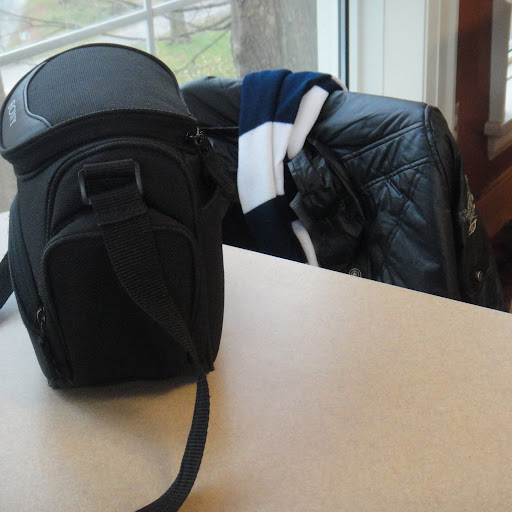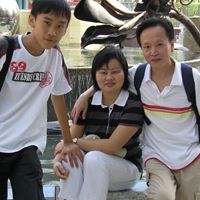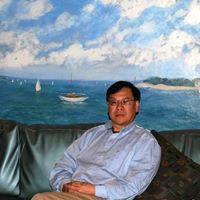Feng Di Jiang
from Salinas, CA
- Also known as:
-
- Feneli D Wang
- Feneli D Dijiang
- Feing Jiang Wang
- Fend D Jiang
- Phone and address:
-
11 Curtis St, Salinas, CA 93906
831 442-8972
Feng Jiang Phones & Addresses
- 11 Curtis St, Salinas, CA 93906 • 831 442-8972 • 831 443-8939
- Gilroy, CA
- Davis, CA
Medicine Doctors

Feng Jiang
view sourceSpecialties:
Hematology/Oncology
Work:
Henry Ford Medical GroupHenry Ford Hematology & Oncology
2799 W Grand Blvd FL 13, Detroit, MI 48202
313 916-1841 (phone), 313 916-7911 (fax)
2799 W Grand Blvd FL 13, Detroit, MI 48202
313 916-1841 (phone), 313 916-7911 (fax)
Education:
Medical School
Xian Med Univ, Xian City, Shaanxi, China
Graduated: 1994
Xian Med Univ, Xian City, Shaanxi, China
Graduated: 1994
Conditions:
Diabetes Mellitus (DM)
Disorders of Lipoid Metabolism
Hypertension (HTN)
Disorders of Lipoid Metabolism
Hypertension (HTN)
Languages:
English
Description:
Dr. Jiang graduated from the Xian Med Univ, Xian City, Shaanxi, China in 1994. She works in Detroit, MI and specializes in Hematology/Oncology. Dr. Jiang is affiliated with Henry Ford Hospital.

Feng Jiang
view sourceResumes

Design Director At Vanke
view sourcePosition:
Design Director at Vanke
Location:
Shenzhen, Guangdong, China
Industry:
Real Estate
Work:
Vanke - Shen Zhen since Jun 2012
Design Director
Columbia Business School Sep 2010 - Jun 2012
MBA
Leo A Daly Sep 2007 - Aug 2010
Designer
HNTB 2005 - 2007
Designer
Design Director
Columbia Business School Sep 2010 - Jun 2012
MBA
Leo A Daly Sep 2007 - Aug 2010
Designer
HNTB 2005 - 2007
Designer
Education:
Columbia University - Columbia Business School 2010 - 2012
MBA, Real Estate University of Pennsylvania 2004 - 2005
Master, Architecture
MBA, Real Estate University of Pennsylvania 2004 - 2005
Master, Architecture

Phd Candidate, Research Assistant At The University Of Arizona
view sourcePosition:
Research Assistant at The University of Arizona
Location:
Tucson, Arizona
Industry:
Chemicals
Work:
The University of Arizona - Tucson, Arizona Area since Sep 2008
Research Assistant
Nanjing University of Aeronautics and Astronautics - Nanjing Sep 2007 - Jun 2008
Undergraduate Research Assistant
Research Assistant
Nanjing University of Aeronautics and Astronautics - Nanjing Sep 2007 - Jun 2008
Undergraduate Research Assistant
Education:
University of Arizona 2008 - 2013
Doctor of Philosophy (Ph.D.), Chemical Engineering Nanjing University of Aeronautics and Astronautics 2004 - 2008
Bachelor of Applied Science (B.A.Sc.), Applied Chemistry
Doctor of Philosophy (Ph.D.), Chemical Engineering Nanjing University of Aeronautics and Astronautics 2004 - 2008
Bachelor of Applied Science (B.A.Sc.), Applied Chemistry
Languages:
English
Chinese
Chinese

Feng Jiang
view sourceWork:
United States
Isu
Isu

Feng Jiang
view source
Feng Jiang
view source
Officer At Government Of Zhenhai, Ningbo
view sourcePosition:
Officer at Government of Zhenhai
Location:
Rest of Zhejiang, China
Industry:
Government Administration
Work:
Government of Zhenhai since Jul 2012
Officer
Sina Corporation Aug 2006 - Apr 2009
Intern
Officer
Sina Corporation Aug 2006 - Apr 2009
Intern
Education:
University of Houston 2009 - 2011
Master's degree, Public Relations/Image Management Huazhong University of Science and Technology 2005 - 2009
Bachelor's degree, Communication, General
Master's degree, Public Relations/Image Management Huazhong University of Science and Technology 2005 - 2009
Bachelor's degree, Communication, General
Languages:
Chinese

Feng Jiang
view sourceLocation:
United States

Feng Jiang
view sourceLocation:
United States
Us Patents
-
Multiple Access Points Coordination
view source -
US Patent:20210051722, Feb 18, 2021
-
Filed:Oct 30, 2020
-
Appl. No.:17/084755
-
Inventors:Po-Kai Huang - San Jose CA, US
Qinghua Li - San Ramon CA, US
Xiaogang Chen - Portland OR, US
Robert J. Stacey - Portland OR, US
Laurent Cariou - Portland OR, US
Feng Jiang - Sunnyvale CA, US
Yaron Alpert - Hod Hasharoni IL, US -
International Classification:H04W 74/08
H04L 5/00
H04L 27/26
H04W 72/04
H04L 1/00 -
Abstract:Methods, apparatuses, and computer readable media for a common preamble for wireless local-area networks (WLANs). An apparatus of an access point (AP) or station (STA) comprising processing circuitry configured to encode an AP trigger frame that includes a resource allocation for other APs to transmit trigger frames to perform an uplink or downlink multi-user transmission with stations (STAs). The resource allocation includes information so that the transmissions are coordinated at the physical level to lessen interference among the APs and the stations. The processing is configured to encode a trigger frame for multi-AP request-to-send (RTS), the multi-AP trigger frame comprising for each of a plurality of APs, the trigger frame indicating that each of a plurality of APs are to transmit a physical (PHY) protocol data unit (PPDU) comprising a request-to-send (RTS) or multi-user (MU) RTS (MU-RTS).
-
Grouping Of Access Points (Ap) Into Multi-Ap Groups To Enable Coordination Of Downlink Transmissions
view source -
US Patent:20200045555, Feb 6, 2020
-
Filed:Aug 16, 2019
-
Appl. No.:16/543157
-
Inventors:Po-Kai Huang - San Jose CA, US
Daniel Leiderman - Ra'anana, IL
Arik Klein - Givaat Shmuel, IL
Laurent Cariou - Portland OR, US
Daniel F. Bravo - Hillsboro OR, US
Feng Jiang - Santa Clara CA, US
Qinghua Li - San Ramon CA, US
Xiaogang Chen - Hillsboro OR, US
Robert J. Stacey - Portland OR, US -
International Classification:H04W 16/10
H04W 4/06
H04W 72/04
H04W 72/12
H04W 84/20
H04L 25/02
H04W 74/08
H04W 88/08 -
Abstract:Embodiments of an access point (AP), station (STA) and method of communication are generally described herein. The AP may be configurable to operate as a master AP of a multi-AP group. The master AP may establish the multi-AP group by: transmitting one or more messages to advertise the multi-AP group; and exchanging signaling with one or more of the other APs of the multi-AP group. The signaling may include at least one message related to one of the other APs joining the multi-AP group. The master AP may establish the multi-AP group to enable usage of AP Trigger Frames (AP TFs) for coordination of resources to be used for downlink transmissions of the APs of the multi-AP group.
-
Enhanced Signaling And Use Of Multiple Transmission Chains
view source -
US Patent:20190349067, Nov 14, 2019
-
Filed:May 24, 2019
-
Appl. No.:16/422330
-
Inventors:Po-Kai Huang - San Jose CA, US
Yaron Alpert - Hod Hasharon, IL
Laurent Cariou - Portland OR, US
Xiaogang Chen - Portland OR, US
Feng Jiang - Santa Clara CA, US
Qinghua Li - San Ramon CA, US
Robert Stacey - Portland OR, US -
International Classification:H04B 7/06
H04B 7/0408
H04L 5/00
H04W 72/04
H04B 17/309 -
Abstract:This disclosure describes systems, methods, and devices related to signaling and use of multiple transmission chains. A device may determine bits indicative of eight or fewer spatial streams. The device may encode the bits by generating an indication of more than eight spatial streams. The device may determine one or more fields of a frame, the one or more fields including the encoded bits. The device may send the frame.
-
High Efficiency (He) Beacon And He Formats
view source -
US Patent:20190238259, Aug 1, 2019
-
Filed:Apr 12, 2019
-
Appl. No.:16/382531
-
Inventors:Po-Kai Huang - San Jose CA, US
Feng Jiang - Santa Clara CA, US
Xiagang Chen - Hillsboro OR, US
Qinghua Li - San Ramon CA, US
Robert J. Stacey - Portland OR, US
Laurent Cariou - Portland OR, US -
International Classification:H04L 1/00
H04W 40/24
H04W 72/04
H04W 80/02 -
Abstract:Methods, apparatuses, and computer readable media for high efficiency (HE) beacon and HE formats in a wireless network are disclosed. An apparatus of a high efficiency (HE) access point (AP), where the apparatus comprises processing circuitry configured select a tuple from the basic HE-MCS set of tuples, if a basic HE modulation and control scheme (MCS)(HE-MCS) and a number of spatial streams (NSS) set of tuples is not empty, and otherwise select the tuple from a mandatory HE-MCS and NSS set of tuples. The processing circuitry may be further configured to encode a beacon frame in a HE single user (SU) physical layer (PHY) protocol data unit (PPDU), in accordance with the selected tuple, and configure the HE AP to transmit the HE SU PPDU. Null data packets formats, methods, computer readable media, and apparatuses are disclosed for multiple 20 MHz operations.
-
Dynamic Person Queue Analytics
view source -
US Patent:20190080178, Mar 14, 2019
-
Filed:Sep 12, 2017
-
Appl. No.:15/702061
-
Inventors:- San Jose CA, US
Feng Jiang - San Jose CA, US
Nham Van Le - San Jose CA, US
Hugo Latapie - Long Beach CA, US
Enzo Fenoglio - Issy-Les-Moulineaux, FR -
International Classification:G06K 9/00
-
Abstract:In one embodiment, a device identifies, from image data captured by one or more cameras of a physical location, a focal point of interest and people located within the physical location. The device forms a set of nodes whereby a given node represents one or more of the identified people located within the physical location. The device represents a person queue as an ordered list of nodes from the set of nodes and adds a particular one of the set of nodes to the list based on the particular node being within a predefined distance to the focal point of interest. The device adds one or more nodes to the list based on the added node being within an angle and distance range trailing a forward direction associated with at least one node in the list. The device provides an indication of the person queue to an interface.
Classmates

Anna Gui Feng Jiang | Wal...
view source
Walter Crowley Intermedia...
view sourceGraduates:
Anna Gui Feng Jiang (2000-2004),
Sunny Patel (2001-2004),
Ruth Benitez (2000-2003),
Inah Castro (1994-1998),
Tulia Tulia Osorio (1996-2000)
Sunny Patel (2001-2004),
Ruth Benitez (2000-2003),
Inah Castro (1994-1998),
Tulia Tulia Osorio (1996-2000)

Edna Brewer Junior High S...
view sourceGraduates:
Tiffany Sheard (1993-1995),
Alberto Jimenez (1991-1992),
Jiang Feng (1995-1996),
Joann Lawton (1996-1998),
David Bellamy (1997-1999)
Alberto Jimenez (1991-1992),
Jiang Feng (1995-1996),
Joann Lawton (1996-1998),
David Bellamy (1997-1999)
Googleplus

Feng Jiang
Education:
University of Chicago

Feng Jiang
About:
Jphoenix-go.com we sell habachi tool
Tagline:
Jphoenix.service
Bragging Rights:
Habachi teppanyaki

Feng Jiang
About:
Just me...a very simple man
Tagline:
I like travelllll

Feng Jiang
Tagline:
Forward is the only direction~~~

Feng Jiang

Feng Jiang

Feng Jiang

Feng Jiang
Flickr

Feng Jiang
view source
Jiang Feng
view source
Feng Jiang
view source
Fu Feng Jiang
view source
Feng Jiang
view source
Ya Feng Jiang
view source
Feng Jiang
view source
Feng Jiang
view sourceYoutube
Myspace
News

Where does our 'brain waste' go? Scientists think they've figured it out and can use it to treat Alzheimer's
view source- Dr Li-Feng Jiang-Xie, a researcher at Washington University and lead author of the second study, said: These neurons are miniature pumps. Synchronized neural activity powers fluid flow and removal of debris from the brain.
- Date: Jun 26, 2024
- Category: Health
- Source: Google
Get Report for Feng Di Jiang from Salinas, CA














